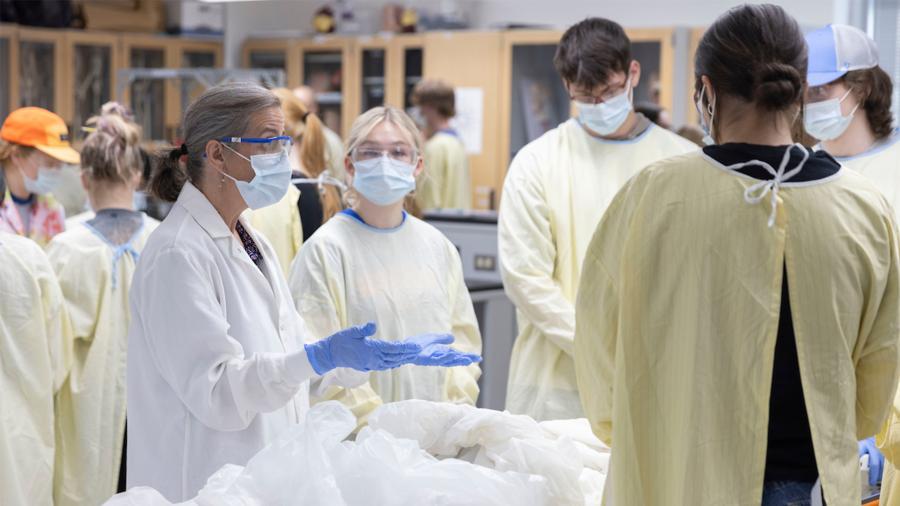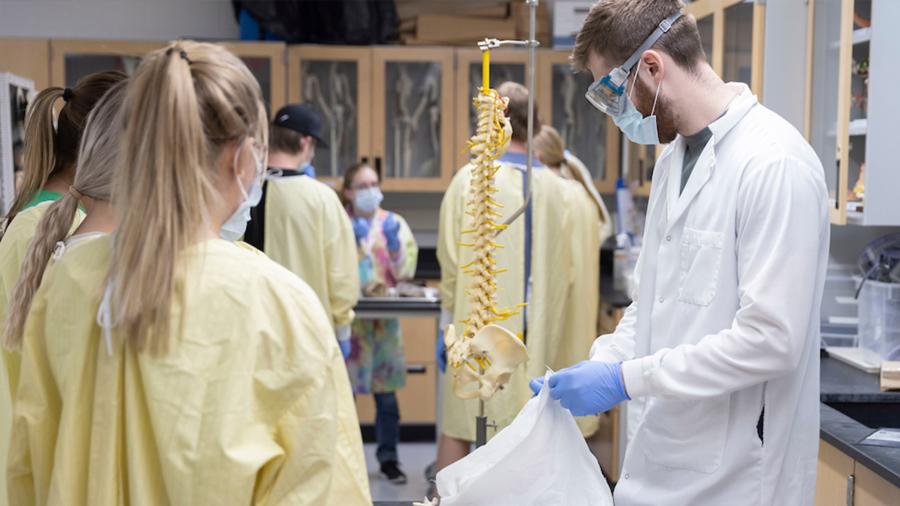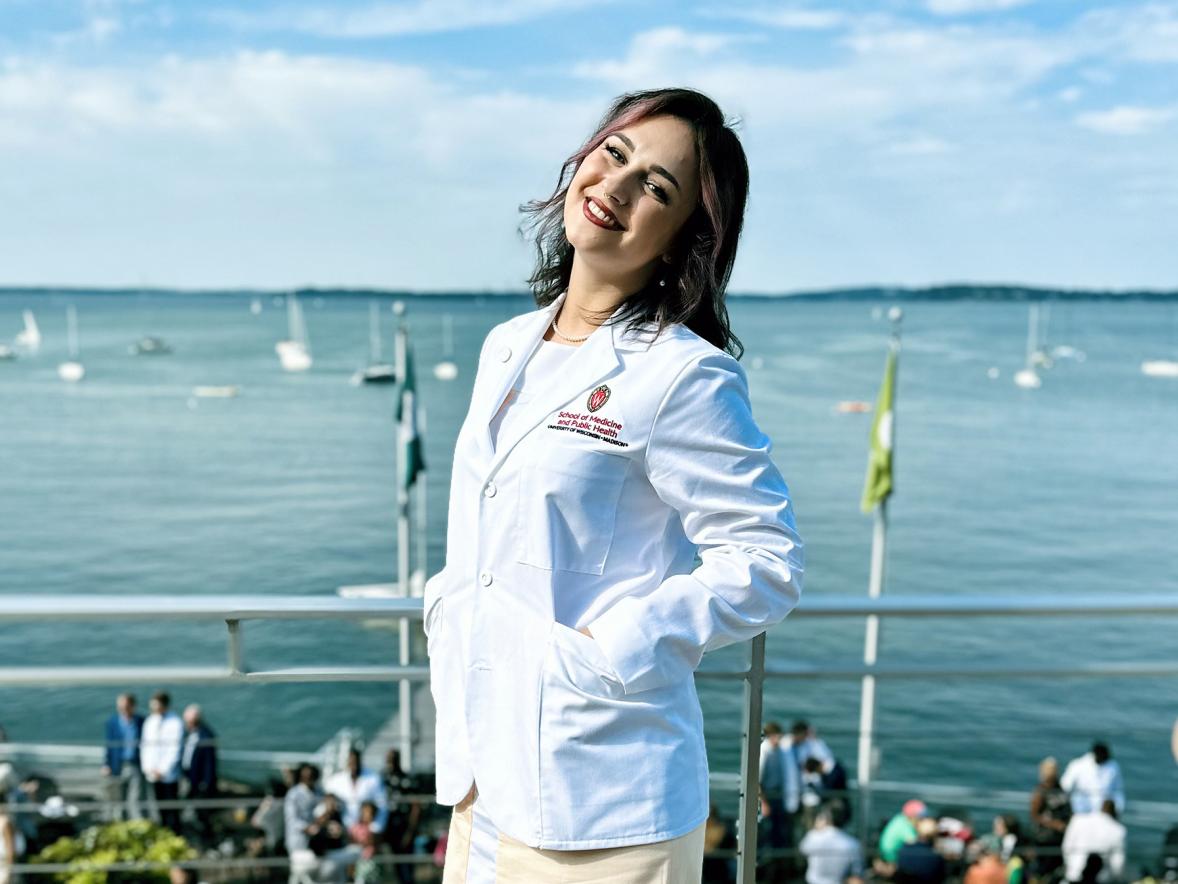Twenty students from Osseo-Fairchild High School became the most recent student group to examine the inner workings of the human body in UW-Stout’s Cadaver Lab in the Jarvis Hall Science Wing.
During their 75-minute visit, they investigated the cardiovascular, gastrointestinal, central nervous and musculoskeletal systems; and the full human body under the guidance of Dr. Alex Hall and three university students – Sarah Loreth, Ethan Kalin and Natalie Mercill.
The juniors and seniors from Osseo-Fairchild had studied many of the major body systems in their high school anatomy and physiology course, and many are planning to pursue careers in medicine. Their teacher, Tera Simpson, who has been at Osseo-Fairchild for 16 years, led them in dissecting a cow eye, sheep heart, sheep brain and fetal pig, but this was their first examination of human systems.

“I think it was so important to see the cadaver as a whole,” Simpson said. “It is one thing to see a heart isolated from the body but a whole different perspective seeing how all parts work together. It was fun to hear the students pick up on things they learned in class and help identify features and ask questions related to their knowledge.”
Three Osseo-Fairchild seniors – Chase Insteness, Ayya Oliver and Breanna Wier – thought the lab helped them better understand human anatomy, as well as to specifically see and feel the difference between a healthy and a cancerous organ.
With an interest in how muscles and bones move, Insteness intends to major in kinesiology; Oliver plans to pursue a career as an ultrasound technician; and Wier as a physical therapist.
“With all of the high school students having a strong interest in science and medicine, it was a great experience to hear from university students on how vast the careers in medicine can be,” Simpson said. “I know that my passions in anatomy and physiology were fueled by the experience, and I hope that students felt the same way.”
A look inside the human body
Eight university student volunteers, who have completed the Cadaver Dissection course, help Hall run the visits. This semester, they’ve led visits for 281 students and 24 adults, from 15 high schools.

“The university students are actually showing the high school students their own work in many cases,” Hall said. “They also have developed expertise in how to demonstrate the specimens and teach about them, which is also an important skill.
“It’s unusual to have cadavers at an undergrad institution and even more rare for the undergrads to actually do the dissection themselves. It’s part of our hands-on approach to learning and emphasis on laboratory experience. Stout has really supported the two cadaver-based courses,” she said.
“I’m so proud of these students. They are such a smart, talented, dedicated and fun group to work with,” she added.
Loreth and Kalin are applied science majors with concentrations in biology at UW-Stout; and Mercill is majoring in biology with a preprofessional health science minor at UW-Eau Claire.
UW-Stout's preprofessional health pathway in applied science prepares students to enter medical school and other health care fields, including chiropractic, dentistry, medicine, occupational therapy, veterinary medicine and more.
Loreth, of Menomonie, led groups at a full body station, where students observed the skeletal muscle systems, and at the gastrointestinal station. Her main interests are physiology and reproductive health. Loreth will graduate in spring of 2025 and plans to enter a nurse midwifery program.

She loves focusing on the muscles of the forearm. “They allow us to do so much with our hands,” she said. “Think of how much we use our hands. Some muscles are such a small segment of our body, but control so much, like the extensor digiti minimi muscle – its sole purpose is to move the pinky.”
“We know a few things about the people who have donated their bodies to the lab, like their careers, age, health factors and cause of death,” she said. “It’s really fascinating to hypothesize what a person’s life was like based on what we observe in the lab.”
Mercill, of Woodbury, Minn., agreed, stating, “The Cadaver Lab has afforded me a perspective on humanity that few ever get the chance to see. I’m grateful to the selfless individuals who have donated their bodies, allowing students to gain a deeper understanding of the complexities that make each of us unique. Thanks to these incredible gifts, we are able to learn and make advancements in scientific research.”

Mercill joined UW-Stout’s Cadaver Dissection course last semester and led the visiting group at the cardiovascular system station, investigating the heart and lungs. She will graduate from UW-EC in spring 2024 and intends to apply to medical school.
“Raised by a family in the criminal justice field, I’ve developed a fervor for investigation and biological forensics,” Mercill said. “I also enjoy crafting and working with my hands, so these reasons are what compel me to pursue a career as a forensic pathologist or an anatomy professor.
“I feel it is especially important for me to be well versed in the cardiovascular and respiratory systems if I am going into a field involving postmortem examinations,” she said. “Heart diseases and cancers, such as lung cancer, are among the most common causes of death in the United States, so it is important to identify them.
“Each time I give a presentation, I am reminded of the remarkable capabilities of the human body, and I feel a renewed appreciation for it,” Mercill added.
Kalin, of St. Paul, led groups at the central nervous system station. He has a minor in cognitive neuroscience. He will graduate spring of 2024 and plans to pursue a job in molecular cell biology or neuroscience research, then would like to attend graduate school for a doctorate of neuroscience.
“The central nervous system is an amazing system of the human body, and its complexity makes it super fun to work with. It’s our pipeline to interacting with and experiencing the world,” he said.

Kalin and students investigated the cerebrum, cerebellum and brainstem, and they talked about the functions of the right versus the left side of the brain. They observed gray and white matter and discussed the thalamus and hippocampus and their roles in memory storage, emotions and learning. They looked at examples of an embolism, a shunt implant and signs of neurodegenerative diseases, like Alzheimer’s or dementia.
“If I had a chance to visit the Cadaver Lab in my high school anatomy class, I would have jumped at it. This is an amazing experience that I totally wish I had when I was considering human biology as a career option,” Kalin said.
With three times as many labs and studios as classrooms on campus, UW-Stout's polytechnic advantage offers students hands-on applied learning and collaboration in career-focused courses.
A unique experience comes full circle
Hall worked as a family physician for 20 years and has lectured in UW-Stout’s biology department for more than a decade. Professor Ann Parsons, who started the cadaver courses at the university, began offering Cadaver Lab visits about a decade ago.
“Students at Stout really benefit from the Cadaver Lab courses, as there’s truly nothing like actually searching for and finding the different anatomical structures in situ. It’s an intensive and immersive experience,” Hall said.
Loreth, Kalin and Mercill agreed, stating that the lab gives them a unique perspective into the intricacies of the human body and an advantage in their undergraduate studies because most students don’t enter a cadaver course until medical school.
Michael Maenner, a 2018 applied science graduate with a minor in human physiology, participated in Hall’s dissection class while in the program. He returned to UW-Stout for his science teaching degree, graduated in 2022 and now teaches at Elk Mound High School.
Maenner recently returned to the lab, bringing 16 students from his anatomy and physiology class for a tour.
“I wanted my class to see the real thing. We look at pictures and use models in our own classroom, but they aren't truly accurate,” he said. “Everything often looks so ‘perfect,’ and the human body really isn’t. Pictures make muscles and organs look perfectly separated but the body is so tightly compacted on the inside it can be hard to differentiate things. Just being able to compare them was very eye-opening to my students.”
Maenner feels like he has come full circle as an educator returning to the lab with his students. He uses many of the techniques he learned from Hall to teach his students about various body systems.
“I just hope I am able to pass on the same enthusiasm for science and learning that Dr. Hall instilled in me. I had a great time as a student at Stout and Dr. Hall's classes played a large role in that,” he said.







